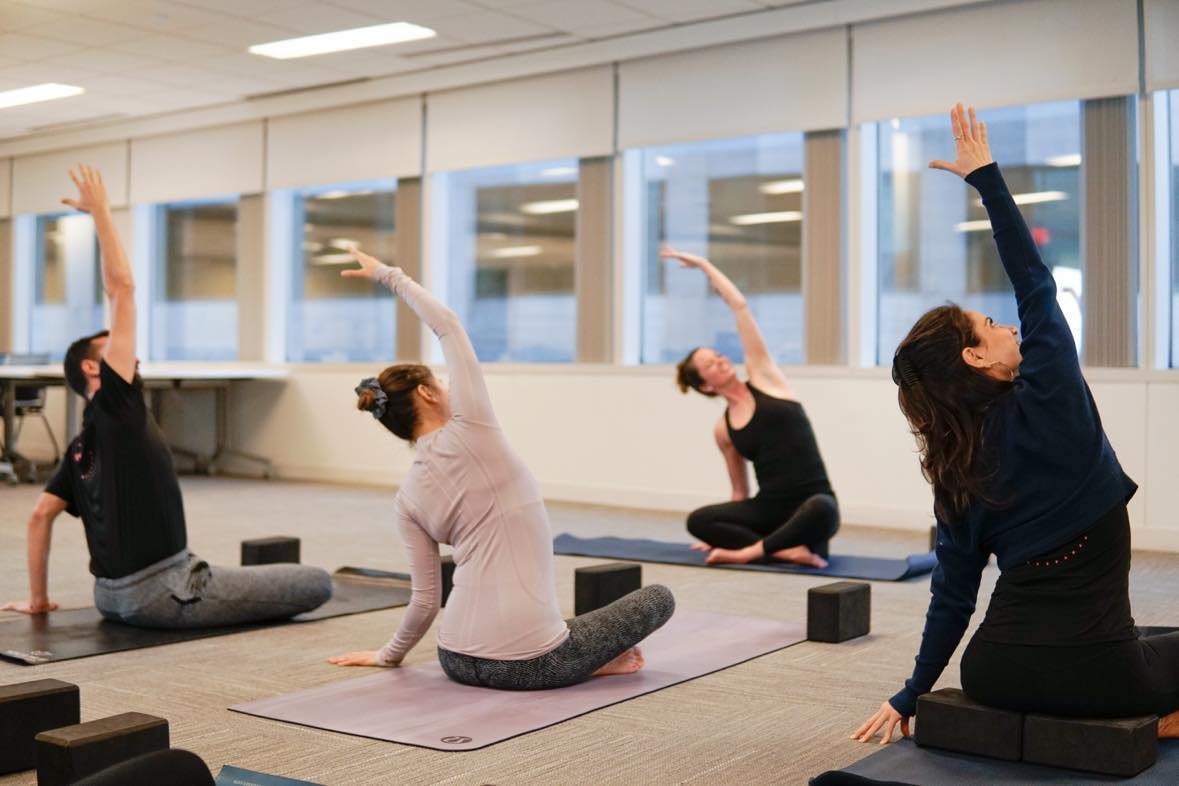Get Your Yoga Practice Started: FAQs Answered
Let's take a closer look at some of the most frequently asked questions about yoga in today's blog post. No matter how experienced you are as a yogi, it is always good to learn more about the practice. So, let's dive in and get some answers to those burning yoga questions!
What is Yoga?
Yoga is a practice of uniting the mind, body, and spirit. It originated thousands of years ago and has taken on many forms. Today, most yogis focus on physical poses (“asana”), which aim to purify the body and prepare for extended periods of meditation. Scientific research has shown that practicing yoga offers numerous physical and psychological health benefits.
What are the benefits of yoga?
Yoga can provide numerous physical, mental, and emotional benefits. Physically, it can help to improve flexibility and strength, as well as reduce stress and fatigue.
Mentally, yoga can help to improve focus and concentration, as well as reduce anxiety and increase relaxation. Discover how yoga can improve mental health and what techniques can be used to do so.
Emotionally, it can help to create a sense of peace and well-being, and improve your overall sense of self-worth. Additionally, yoga can be practiced in a variety of ways, making it accessible to people of all ages and abilities. With so many positive potential outcomes, it is no wonder why so many people today are giving yoga a try.
Is yoga a religion?
No, yoga is not a religion. It originated in ancient India and has many different forms of practice, including physical postures, breathing techniques, and meditation. While yoga has many threads that connect with Hinduism, it is not tied to any specific religion. Yoga is practiced by people of all faiths or no faith at all.
The following points illustrate how yoga is not a religion:
Yoga has no deity to worship.
Yoga has no worship services to attend.
Yoga has no sacred icons.
Yoga has no creed or formal statement of religious belief.
Yoga has no requirement for a confession of faith.
Yoga has no ordained clergy or priests to lead religious services.
Yoga has no institutional structure, leader or group of overseers.
Yoga has no membership procedure.
Yoga has no congregation of members or followers.
Yoga has no system of temples or churches.
I am not flexible. Is yoga a right for me?
It's a common myth that you must be flexible or strong to do yoga; however, the truth is that yoga is adaptable and provides opportunities to improve your flexibility and strength in every class. Yoga practice can emphasize the breath, mind, and spirit equally, or in some cases more than the physical body. For those who want physical practice, some yoga students start with very limited flexibility and then grow to have much more mobility and agility than ever before. Other students may find that yoga practice does not resonate with their body type, and move on to other forms of movement that come more naturally to them. In any case, we recommend you try it out before making your decision. Because saying you can't do yoga because you're inflexible is a bit like saying you can't lift weights because you're weak. Give it a try and see how you feel before you write it off!
Can men practice yoga?
Yoga is an inclusive practice that welcomes both men and women. Today, yoga classes are largely attended by female yoginis, yet it's interesting to note that women used to be forbidden from practicing yoga. Nevertheless, with the evolution of the practice, it has become inclusive and accessible to all. Yoga does not discriminate based on gender, and anyone can join a class where they will be welcomed into a non-judgmental space for practice.
I want to practice yoga, but I don't know how to start. What should I do?
Don't worry if you're new to yoga and don't know where to begin! To get started, find a studio or gym in your area that offers yoga classes and enroll in a beginner's class. Take advantage of studios' free or discounted introductory classes to try out different styles of yoga and find your favorite.
If you prefer to practice at home, there are many online resources available, including instructional videos and virtual classes. It must be noted though, that in-person classes provide more personalized instruction, and can be a much more meditative experience.
Find out if your company's HR department or wellness program coordinator offers yoga classes or memberships. Trying out office yoga with your colleagues in a supportive and familiar environment is a great way to get started with yoga. Additionally, some companies offer discounts or reimbursements for gym or studio memberships, making yoga more affordable.
The most important thing is to listen to your body and start with the basics. Do not worry about keeping up with the other students or pushing yourself beyond your limit. Be mindful of your alignment, breathing, and mindfulness while performing each pose. It takes time and practice to build strength, flexibility, and confidence. According to our yoga instructors, here are some reasons why yoga students should stop worrying and love the process of yoga.
What if I have pain or a previous injury, can I still practice yoga?
If you have pain or a previous injury, it's important to consult with your healthcare provider before starting a yoga practice. However, in many cases, practicing yoga can help alleviate chronic pain by helping the body regain its balance between strength and flexibility, movement, and awareness. It's important to communicate with your yoga teacher prior to the class about any injuries or limitations you have so they can offer modifications or alternative poses. With proper guidance and a gradual approach, yoga can be a safe and beneficial practice for individuals with injuries or pain.
What type of yoga should I practice?
There are many forms of yoga, each with its own benefits and characteristics. To determine the best style of yoga for you, ask yourself why you want to practice yoga, and seek out a teacher who can accommodate your preferences. Experiment with different styles of classes, as some yoga practices are fast-paced and others are slow, while some are meditative and others restorative. Private lessons are a great way to develop a customized practice to suit your needs, and a great teacher can help you establish your own personal style of yoga, giving you the confidence to practice independently or attend group classes if that's your goal. Keep searching until you find the style of yoga that is right for you.
You can choose from a variety of yoga types, including:
Hatha Yoga
Iyengar Yoga
Vinyasa Yoga
Hot Yoga
Ashtanga Yoga
Bikram Yoga
Yin Yoga
Restorative Yoga
Prenatal Yoga
Anusara Yoga
Kundalini Yoga
Hatha yoga is a physical form of yoga, focusing on the practice of postures and breathing techniques. Beginners will benefit from this type of yoga since it includes a slower pace, making it easier to learn and master the different poses.
Vinyasa yoga involves linking movement and breath together and is more athletic in nature. For those who wish to increase their strength, flexibility, and endurance, this type of yoga is ideal.
Ashtanga yoga is a type of yoga that consists of a specific sequence of postures. It is suitable for those who like routine and want to progressively advance practice by practice.
In Iyengar yoga, props such as blocks, belts, and blankets are used to help align the body into the poses. As a beginner, this type of yoga provides a great option because it permits you to learn proper alignment of your body while practicing it.
A spirituality-centered form of yoga, Kundalini yoga focuses on activating the body's energy centers. If you are looking for a way to increase your energy level as well as your vitality, and you don’t mind chanting, this type of yoga is a powerful way to create change within your whole being.
Yin yoga focuses on stretching and lengthening the connective tissue through slow-paced movements and long posture holds.
What kind of yoga is best for beginners?
The best type of yoga to start with if you are new to yoga is Hatha yoga. A gentle form of yoga, Hatha yoga emphasizes slow movements and controlled breathing. It’s a great way for beginners to learn basic poses and learn how to transition between them. Try finding a class that is specifically for beginners, as these classes are adjusted to newbies' needs.
What should I wear to a yoga class?
Wear comfortable clothing that allows you to move freely and breathe easily. Choose athletic wear that will allow the instructor to view your body's alignment clearly while also allowing you to exercise freely. Furthermore, choose fabrics that are comfortable and breathable, or for hot yoga classes, quick drying.
What should I bring to a yoga class?
Here are a few items you should bring with you to yoga class to ensure an enjoyable and comfortable experience:
During your practice, it's important to stay hydrated, so don't forget to bring a water bottle.
In addition, bringing your own yoga mat is a good idea, as it gives you a sense of familiarity and comfort. You don't need to bring a yoga mat if you don't own one or don't like to do so - many yoga classes rent mats or have them available for use. It is important to keep in mind that owning your own mat can be beneficial for reasons of personal hygiene and convenience.
Additionally, bringing a towel is a good idea, as yoga classes can sometimes be sweaty, and a towel can help you stay dry and comfortable.
What should I do if I feel any pain while practicing yoga?
If you are feeling any pain while practicing yoga, you should stop pushing further and assess the situation. Pay attention to where the pain is coming from, how intense it is, and if there are any other accompanying sensations like numbness or tingling. If the pain is severe or persists, it's best to take a comfortable resting pose and after class, consult with a medical professional. If the pain is mild and tolerable, you can try adjusting your position, using props, and modifying the pose to make it more comfortable. Always listen to your body and do not push yourself beyond your limits.
How can I stay motivated to practice yoga regularly??
When it comes to staying motivated to practice yoga regularly, the key is to find an enjoyable routine that you can stick to. Look for an awesome instructor who inspires you! It might be helpful to set a regular time each day when you practice yoga, and structure this into part of your daily routine so that you don't forget. You could also find a yoga class or group to join, allowing you to practice with other people who can help keep you motivated. Finally, take note of the physical and mental benefits that yoga brings outside of practice, such as improved flexibility, strength, concentration, and an overall sense of peace and wellbeing. Practicing yoga can become an enjoyable experience that you look forward to, rather than a chore.
Attain a workforce that is thriving mentally and physically with a customized employee wellness program
A comprehensive employee wellness program should be tailored to the culture of the organization and foster balance in the life of its employees. To enhance the employee experience, it's crucial to select a program that prioritizes not only physical health but also mental wellness.
Transform your workplace into a healthy and productive environment with YogaHub's customizable corporate wellness program! Emphasizing mindfulness and physical wellness through yoga and meditation, our program will help improve the well-being of your employees. Don't wait, take the first step towards a healthier workplace today and contact YogaHub to learn more about our innovative wellness program!


